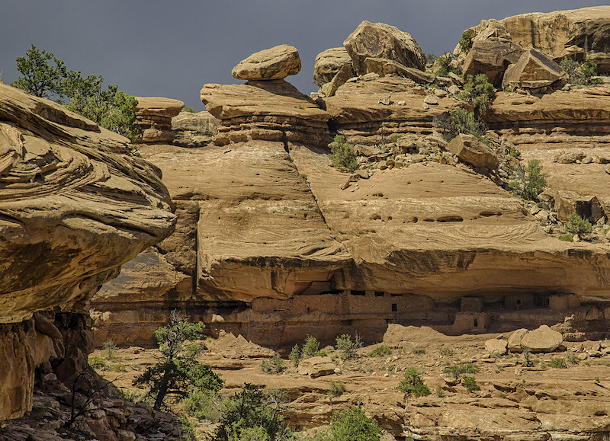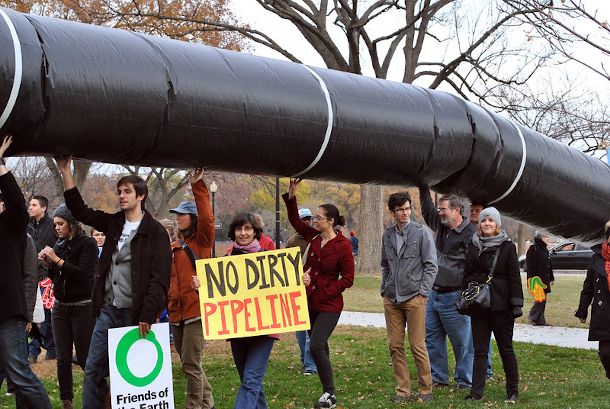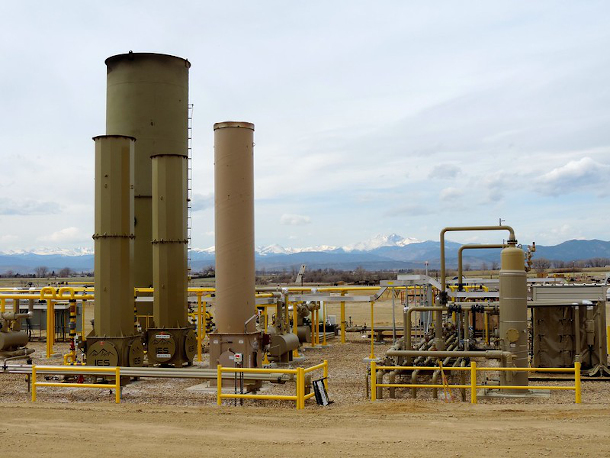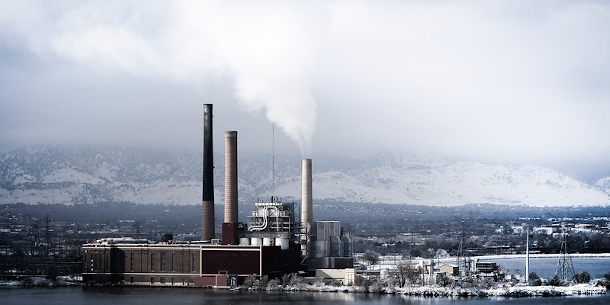Biden Reverses Trump Rollbacks
Air Date: Week of January 22, 2021

President Biden immediately signed an executive order that directs many actions including reviewing the option to restore Bears Ears National Monument, which former President Trump reduced in size by 85%. The dramatic desert landscape is home to abundant rock art, ceremonial kivas, and ancient cliff dwellings including Moon House, above. (Photo: Bob Wick / BLM, Flickr, CC BY 2.0)
Hours after taking the oath of office, President Biden signed executive orders restoring environmental protections removed by his predecessor. Steve Curwood and Bobby Bascomb take stock of his first executive actions and put them in context. And with narrow Democratic control of Congress, President Biden and his party could also make use of the Congressional Review Act to quickly undo recent Trump administration rules. Romany Webb of the Sabin Center for Climate Change Law at Columbia University joins Host Steve Curwood to discuss the appeal and perils of using this tool.
Transcript
CURWOOD: It’s Living on Earth, I’m Steve Curwood.
BASCOMB: And I’m Bobby Bascomb.
So, Steve, re-joining the Paris agreement is a huge step forward for the United States to get back on track when it comes to working with the international community to tackle climate change.
CURWOOD: It most certainly is, and President Biden has been wearing out his pen since the 20th on domestic environmental issues as well, undoing much of former President Trump’s environmental damage. I understand you’ve been looking into some of those actions for us Bobby.
BASCOMB: Yeah I have! Shortly after the inauguration Joe Biden signed more than a dozen executive orders, several of them about the environment. Among them, he directed the Interior Department to review the boundaries for several national monuments that were shrunk by the Trump administration.
CURWOOD: Oh, yeah. I mean famously, the Bears Ears national monument was made about 85 percent smaller to allow uranium mining and drilling for oil and gas.
BASCOMB: Right, President Biden has said all along that he wants to put a halt to new oil and gas leases on public lands and he took a first step towards that by placing a temporary moratorium on oil and gas leases in the Arctic National Wildlife Refuge. And Mr. Biden cancelled the permit for the Keystone XL pipeline.

A temporary moratorium on oil and gas leasing in the Arctic National Wildlife Refuge was among President Biden’s many first-day actions. (Photo: Danielle Brigida, Flickr, CC BY 2.0)
CURWOOD: That’s been a political football for a decade. Protestors even went to jail in a bid to get President Obama to kill it. Those activists said that burning all the carbon-heavy tar sands oil that would be transported by Keystone XL would mean game over for the climate if we were to allow the pipeline to move forward.
BASCOMB: And Native American groups have been protesting it since day one, they’re concerned that a spill could damage in ecologically sensitive and culturally sacred areas along the route from Alberta, Canada to refineries on the Gulf Coast. So, President Obama eventually rejected the pipeline only to have President Trump give it the green light, he said it was important for the economy and job creation, again reviving the controversy. It got bogged down in court battles and with all the delays now it’s not a huge priority for the oil industry, given the low cost of a barrel of oil today. So, to some degree you could argue that this is a symbolic gesture by President Biden, but he is certainly signaling his intention to take the issue of climate change seriously.
CURWOOD: Yeah, and he says that he wants the US to be carbon neutral by the year 2050.
BASCOMB: Exactly, it’s such an ambitious goal. But to help us get there he issued another executive order telling federal agencies to look again at methane rules and fuel and building efficiency standards.
CURWOOD: Yeah and so, maybe an end to the standoff with California about their stricter fuel efficiency standards for cars?
BASCOMB: Probably so, yes.
CURWOOD: Yeah but still, I feel like we’ve spent the last four years reporting on the dozens of environmental laws and regulations that former President Trump rolled back or weakened. Mr. Biden and his team are going to be very busy!
BASCOMB: Oh gosh they certainly are. And you’re right, the total number is more than 100. But with a stroke of that pen back on inauguration day President Biden also moved to reconsider Trump rules that quote “were harmful to public health, damaging to the environment or unsupported by the best available science.” So, I think we can expect the new administration to move quickly to address the climate and the environment, more broadly. Of course, changing the rules for federal agencies can and often does take years. But, there is another way, the Congressional Review Act. It allows a simple majority in Congress and approval by the president to void rules that have been completed during the last sixty legislative days of a previous presidential term, and Steve and you’ve been looking into this for us right?

Climate activists have been battling the Keystone XL pipeline for over a decade, and President Biden revoked its permit on his first day in office. (Photo: chesapeakeclimate, Flickr, CC BY-SA 2.0)
CURWOOD: Yes, Some possible targets are some last-minute Trump Administration rules that cut food stamps for some 3 million people and another that exempts the USDA from certain environmental reviews that could promote increased logging in national forests. And then there’s the widely criticized so-called ‘transparency in science’ regulation, adopted just a few weeks ago by the Trump EPA. Now this deceptively named rule would force researchers to disclose confidential medical data used to study health effects of pollution and toxics. But there is a risk, as rules are taken off the books by Congress can’t be reinstated in “substantially the same form,” and that can tie agency hands in the future. So for more, I want to turn now to Romany Webb, Senior Fellow at the Sabin Center for Climate Change Law at Columbia University. Welcome to Living on Earth Romany!
WEBB: Thank you. It's nice to be here.
CURWOOD: Now Romany, the so-called "transparency in science" rule, also known as the "secret science" rule, was finished by the EPA just a few weeks ago. Why is this rule getting so much attention as a possible target for the Congressional Review Act?
WEBB: Yeah, so the inaptly-named science transparency rule, what it actually does is restricts the Environmental Protection Agency's ability to rely on scientific studies where the underlying data is not publicly available. And to the layperson, that might not sound so bad, but a lot of the studies that EPA relies on of course are public health studies, where the underlying data is confidential medical information that simply can't be disclosed. So it would really restrict the type of studies that the EPA can rely on and has relied on in the past to adopt some of our most important air pollution controls and other regulations. You know, this adoption of the secret science rule or the science transparency rule really generated a lot of controversy for that reason, it's very unpopular amongst environmental organizations and other sort of science advocacy groups. And so definitely, that is one that's being talked about as a possible target for disapproval through the CRA process. It's very unlikely that a Biden administration or even another Democratic administration would want to adopt a rule like the science transparency rule. So, you know, that "substantially similar" language is less of an issue there.
CURWOOD: And while it was named science transparency, some consider this a science inhibition rule in particular, for years industry has contested the health effects of particulates, trying to get at databases where people had given up their health records to demonstrate how deadly particulates are. EPA I believe made some findings ignoring a number of studies that in fact had confidential medical data in them. So this is kind of a big deal.

In the last days of the Trump Administration, the EPA imposed a 3% threshold for regulating greenhouse gas sources that would ignore emissions from the oil and gas sector, which accounts for 2.5% of U.S. greenhouse gases. In fact, the only industrial sector above the 3% threshold is the electric power generation sector. (Photo: WildEarth Guardians, Flickr, CC BY-NC-ND 2.0)
WEBB: Yeah, definitely. And the EPA rule, the science transparency rule or the secret science rule, does not come out of nowhere. This is a rule that actually Congress tried to legislate this requirement, tried to enact legislation that would impose this requirement on EPA multiple times in the past, all of those measures were unsuccessful. And so now that the Trump administration has had control of the EPA, they've decided to do it through an agency rule making process.
CURWOOD: So there's a new rule that the now-vanished Trump administration had put forward that set a 3% threshold for regulating industrial sources under the Clean Air Act. In other words, exempting many, many, many industries, because no one industry is so huge. How might the Congressional Review Act be used to get rid of that?
WEBB: Yeah, the rule you're talking about establishing the 3% threshold really means that only the electric generating sector can be regulated by EPA, under the new source performance standards, the section 111(b) and (d) process. So it effectively excludes from regulation all those other big sources of emissions that fall just below the threshold, so the oil and gas sector, which is upwards of 2.5%, but just doesn't quite make it to 3%, and many others. So there is, you know, some talk that the Congressional Review Act could be used to disapprove of that rule. You know, this "substantially similar" provision, the prohibition on adopting substantially similar rules, is giving some people pause in terms of what that would mean, if this rule establishing the 3% threshold was disapproved through the CRA process, might that limit the adoption of other regulations that future Democratic administrations want to adopt? So that one, I think, is less of a slam dunk than the science transparency rule.
CURWOOD: Now what about the rule that came out of the Trump administration that essentially set financial cost-benefit analysis for cleaning up the air and pretty much ignored co-benefits such as, you know, health benefits, saving lives? There's some effort to get this repealed, I understand.
WEBB: Yeah, I think the cost-benefit analysis rule that was finalized by EPA relatively recently is one that is certainly getting attention for potential review under the CRA. You know, it has been incredibly controversial and, and widely disparaged on the basis that it does prevent consideration of co-benefits, which are a key benefit of many of our rules, and have played an important part in the basis on which many of our rules have been adopted.
CURWOOD: And in fact, doesn't in a way contradict the Clean Air Act itself, which says that strictly cost-benefit is not applicable, or should not be paramount when there are health considerations?

Another recently adopted EPA rule directs the agency to ignore co-benefits such as lives saved by reducing air pollution. (Photo: CAJC: in the PNW, Flickr, CC BY-NC-ND 2.0)
WEBB: Yeah, I mean, there's, you know, quite complicated rules around how economic considerations should factor into rules adopted under the Clean Air Act. Certainly the Clean Air Act is not solely an economic statute, and it's not intended to be one. The agency cannot solely consider economic factors and in some cases is prevented from considering economic factors when adopting rules. So, you know, this attempt by the Trump administration to further inject economic factors into decision making, but to restrict the nature of those factors that can be considered is problematic on multiple fronts.
CURWOOD: Romany Webb is a Senior Fellow at the Sabin Center for Climate Change Law at Columbia University. Romany, thanks so much for taking the time with us today.
WEBB: Thanks, Steve.
Links
Columbia’s Sabin Center: “Climate Reregulation in a Biden Administration”
NRDC: Read about the long battle against the Keystone XL pipeline
The Sabin Center’s Climate Deregulation Tracker
The Sabin Center now has a Climate RE-Regulation Tracker
Slate | “Democrats Have a Filibuster-Proof Tool to Erase the Trump Administration’s Final Months”
Living on Earth wants to hear from you!
Living on Earth
62 Calef Highway, Suite 212
Lee, NH 03861
Telephone: 617-287-4121
E-mail: comments@loe.org
Newsletter [Click here]
Donate to Living on Earth!
Living on Earth is an independent media program and relies entirely on contributions from listeners and institutions supporting public service. Please donate now to preserve an independent environmental voice.
NewsletterLiving on Earth offers a weekly delivery of the show's rundown to your mailbox. Sign up for our newsletter today!
 Sailors For The Sea: Be the change you want to sea.
Sailors For The Sea: Be the change you want to sea.
 The Grantham Foundation for the Protection of the Environment: Committed to protecting and improving the health of the global environment.
The Grantham Foundation for the Protection of the Environment: Committed to protecting and improving the health of the global environment.
 Contribute to Living on Earth and receive, as our gift to you, an archival print of one of Mark Seth Lender's extraordinary wildlife photographs. Follow the link to see Mark's current collection of photographs.
Contribute to Living on Earth and receive, as our gift to you, an archival print of one of Mark Seth Lender's extraordinary wildlife photographs. Follow the link to see Mark's current collection of photographs.
 Buy a signed copy of Mark Seth Lender's book Smeagull the Seagull & support Living on Earth
Buy a signed copy of Mark Seth Lender's book Smeagull the Seagull & support Living on Earth

